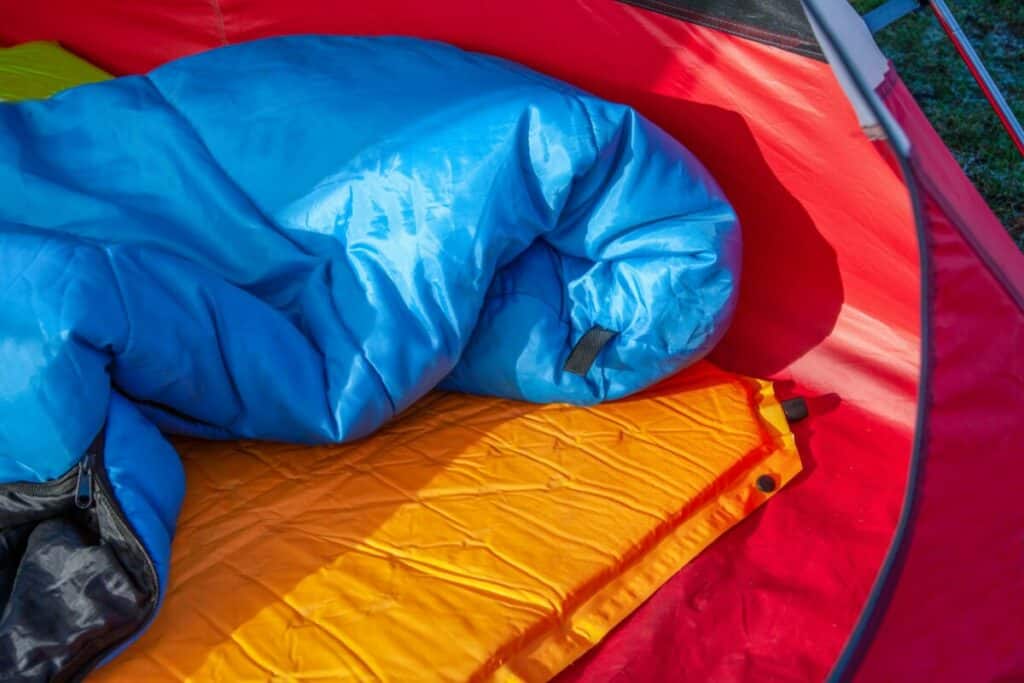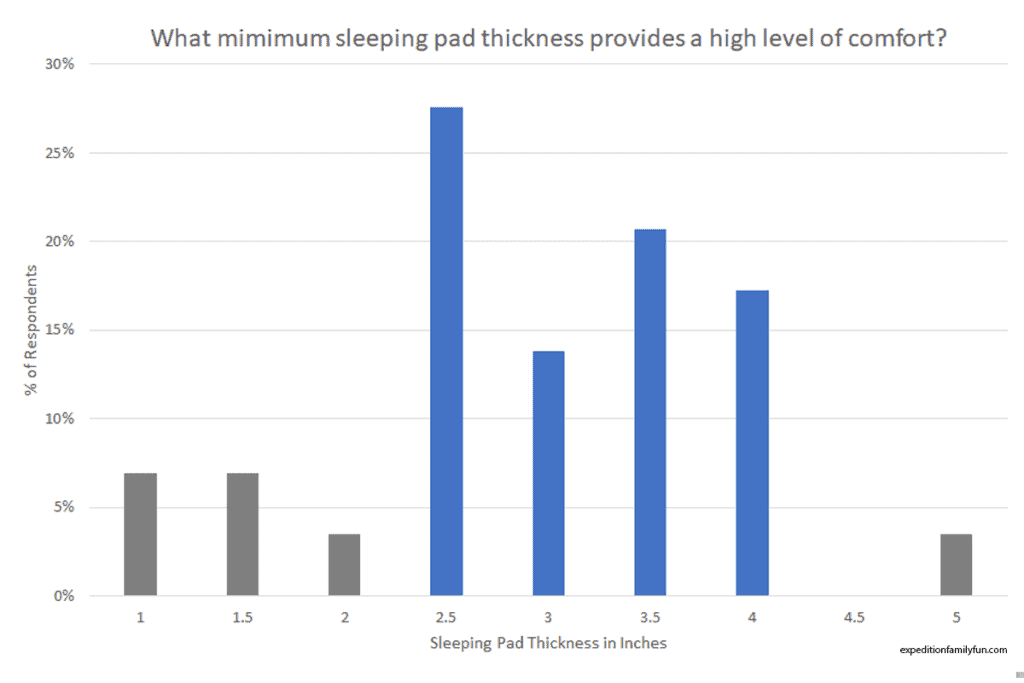
Having a good sleeping pad is essential to getting a good night’s sleep while camping or backpacking. As all campers know, a good night’s sleep can make a world of difference on a trip. You may think that the thicker the pad, the comfier it will be, but that may not always be the case.
The most widely used thickness for a sleeping pad for camping and backpacking is 2.5 inches. However, sleep position, weight, sensitivity to hard sleep surfaces and activity (i.e. backpacking vs car camping) can all influence the ultimate sleeping pad thickness for an individual.
Let’s talk a bit more about each of these factors and how they can help you determine which thickness of the sleeping pad would best suit you and your needs.
Sleeping Pad Thickness Standards
Sleeping pads usually range in thickness from 1-4 inches, with variances for the type of activity you plan to do. Backpacking sleeping pads are thinner in order to cut down on weight, while (car) camping sleeping pads can afford to be thicker and heavier. Car campers may also use extra thick air mattresses that try to mimic their mattresses at home.
Backpacking Sleeping Pads
- 1 inch or less: Sleeping pads that are this thin are definitely the lightest option for backpackers, but are also probably the least comfortable option out there. They are most often made out of foam and provide limited cushioning and insulation from the cold, hard ground. Foam pads can also be much more bulky to transport than air pads and are therefore often carried on the outside of backpacks.
- 1.5 inches: Most sleeping pads you will see on the market today at this thickness are self-inflating and fairly comfortable due to their internal combination of foam and air. Self-inflating pads are usually heavier and bulkier than air pads due to these foam cores and are therefore more appropriate for camping than backpacking.
- 2.5 inches: This is the current standard for backpacking air pads. These pads can be lightweight, while still putting a good amount of distance between the sleeper and the ground, even for side-sleepers. The most popular premium backpacking air pads are 2.5 inches.
- 3 inches or more: Three plus inches of thickness is most often found in deluxe air pads that are car camping comfort-focused. Sea to Summit Ether Light XT pads are one lightweight backpacking exception at 4 inches.
Camping Sleeping Pads
- 2.5 – 4 inches: As with backpacking pads, a two inch thickness is needed for adequate cushioning for most people. Comfort-focused pads are often 4 inches. Most camping pads are self-inflating and much thicker, heavier and bulkier than the more specialized backpacking pads.
- 5 or more inches: When camping, some people prefer to use air mattresses that are similar in thickness to the mattresses on their beds at home. Camping air mattresses can be as thick as 24 inches! These mattresses are quite heavy and can take up considerable cargo space.

Types of Sleeping Pads
The type or structure of a sleeping pad has a lot to do with how comfortable it is. Foam pads are usually the cheapest, but they are typically limited to the super thin category and are therefore generally less comfortable. Air and self-inflating pads are pretty similar in price and comfort levels.
- CLOSED-CELL FOAM: Foam sleeping pads are made from compressed foam with small pockets of air that give the pad a bit of insulation. One plus is that in comparison to self-inflating or air sleeping pads is that they are more durable. You can be a bit rougher with a closed-cell foam pad because you don’t have to worry about it popping. Although they are more durable and a lot cheaper than other pads, they are almost exclusively sold at the 1 inch or less thickness and therefore are not the most comfortable. They are often bulky, no matter how lightweight they may be.
- SELF-INFLATING: Self-inflating pads are some of the most popular pads used today. They are a hybrid between foam and air pads. To inflate the pad, you usually just need to roll it out and open a valve until the pad is full of air. You will typically need to add some air. Although they can be heavy and bulky, there are some self-inflating pads that are lighter and less bulky, made specifically for backpacking. Self-inflating pads tend to be more comfortable than air pads of a similar thickness due to the greater stability of these pads. Their foam and air structure gives them a feel that is more similar to a bed mattress, especially the thicker deluxe pads.
- AIR: Unlike foam and self-inflating sleeping pads, air sleeping pads rely solely on air to give users optimal comfort. Air pads are the lightest available option and are great for backpackers because they pack down small. That being said, they are generally more expensive than other sleeping pads of a similar thickness and are made of a thin, less durable material. Air pads lack the base foam core of self-inflating pads and therefore do not retain any comfort or insulation when deflated or otherwise maximally compressed. Super thick air mattresses may lack adequate insulation despite their thickness.
Factors to Consider
Although the standards for sleeping pad thicknesses are listed above, you will need a thicker or thinner pad based on your specific needs. Here are the key factors that you should consider before buying one:

SLEEPING POSITION
How you sleep can also affect how thick you will want your sleeping pad. People who sleep on their stomachs or side will want a thicker sleeping pad. When you sleep on your stomach or side, your hips press into the ground more than the rest of your body. A thicker sleeping pad will protect your hips and keep you from tossing and turning to relieve pressure from your bones all night. If you sleep on your back, you will be comfortable on a thin or thick sleeping pad.
SIZE AND WEIGHT
Although weight isn’t a huge factor for campers, it is very important for backpackers who have to carry all their gear on their back for miles. You would not want to carry a 20 pound queen-sized air mattress in your backpack. Air sleeping pads are definitely the lightest option since they don’t have any thick material or foam weighing them down. The lightweight backpacking air pads are generally limited to 2 to 4 inches in thickness.
Air pads also compress into small bags which means they won’t take up too much space in your pack or car. You would be surprised by how much cargo space you can save in your car by using the more compact backpacking air pads for a large family like mine.
GENERAL SENSITIVITY TO SLEEPING ON HARD SURFACES
Some people prefer hard mattresses and could easily pass out on a hard floor, especially if exhausted after a day of hiking. They may even pride themselves in being able to sleep on a 1/4 inch pad. Others may struggle to sleep comfortably in a tent and may need every possible edge in their camping or backpacking sleep system. I am sure you know which category you fall into. Try out various options in store (e.g. REI), but if comfort is your focus, start at the 2.5 inch thickness and include the deluxe self-inflating pads in your search.
Insights from Our Community
Our community of experienced campers and backpackers had the following to say about sleeping pad thickness comfort:
The minimum comfortable thickness for sleeping pads was 2.5 inches. The comfort zone for sleeping pads for these experienced adventurers was 2.5 to 4 inches. The ability to sleep comfortably on your side was a key factor that drove this answer.
Some mentioned that pad design should be a consideration. For example, Klymit pads are 2.5 inches, extremely light and an excellent value, but may not be a good choice for those seeking a highly cushioned sleeping experience due to their unique V design. However, I am a side sleeper and have slept comfortably on these. Design and construction can influence an individual’s comfort regardless of thickness, especially for the premium pads. Some of the lightest, most expensive pads may keep you at night by the noise they make due to their internal design.

